
THE VOICE OF INTERNATIONAL LITHUANIA
|
VilNews has its own Google archive! Type a word in the above search box to find any article.
You can also follow us on Facebook. We have two different pages. Click to open and join.
|
How I came to Lithuania 21 years ago (4 of 6)
Some private memories by Aage Myhre, VilNews Editor-in-Chief
aage.myhre@VilNews.com
January 1991:
Soviet rolls back

18 January 1991: It is very touching to see how the Balts act to keep their newfound freedom and protect their home country during the very difficult January days of 1991. Here, at the entrance to the Lithuanian Foreign Ministry, the young men have put on homemade clothes that are meant to look like uniforms. They carry rifles and other weapons they have found in their homes. Sand bags have an important symbolic effect. Brave guys!
Photo: Aage Myhre, 18 January 1991.
In the summer of 1990 we heard Parliament President Landsbergis tell us that he feared a new Soviet attack after Lithuania had declared independence in March of that year. “For Gorbachev, our freedom declaration was very hard to accept, although he towards western countries pretended that everything was in perfect order," Landsbergis told us. When we first came to Lithuania the autumn of 1990, finding everything calm and balanced, it was hard to believe that there was any real reason for his fear.
But he's right. In January 1991 Soviet tanks again roll through the streets of the capitals Tallinn, Riga and Vilnius. Soviet Special Forces take control of radio and television stations, surround the parliaments, ready to use armed force against the governments of the three countries. In Vilnius 14 young people are killed in their attempt to stop the attackers.
When these dramatic events take place, the three Baltic States - Estonia, Latvia and Lithuania - already for three years have fought a quiet, heroic struggle against overwhelming odds. Western countries have ignored this, as they did when the Soviet Union annexed the Baltic States during World War II and refused to give these states back their freedom when the war was over.
Now the Balts are again left alone in their struggle for justice. But they refuse to give up!
The most visible symbol of this new battle took place 23 August 1989, when about two million Balts held hands and formed a human chain that stretched 600 kilometres from north to south through the three Baltic States.
The chain marked the 50th anniversary of the Molotov-Ribbentrop Pact between the Soviet Union and Nazi Germany. The pact and its secret protocols divided Eastern Europe in spheres of influence, and led to the occupation of the Baltic States in 1940. Behind this remarkable event in 1989 stood the Baltic independence movements Rahvarinne (Estonia), Popular Front (Latvia) and Sąjūdis (Lithuania).
The 1989 event gave the Baltic activists an opportunity to make the world aware of the illegal Soviet occupation. The authorities in Moscow, however, responded to it all with intense rhetoric, failing to take constructive steps that could have built bridges over the increasing gap between the Baltic States and the Soviet Union. Six months after the protests, Lithuania became the first republic to declare independence after 50 consecutive years of abuse and an occupation the Balts could never accept.
Now, in January 1991, the Soviets new invasion has become a sink or swim for the people here in the Baltic States..

We, our Norwegian team, together with journalists travelled to Latvia and Lithuania as soon as we could after the Soviet attack in January 1991. The Balts refused to accept the Soviet invasion. They did their utmost to protect their governments and media. Here we are with 'activists' in Riga. They light bonfires and stay overnight in tents to demonstrate against the new Soviet assault.
Photo: Aage Myhre, January 1991.

Without the intense media coverage that took place in January 1991 the outcome could well have been another. Occupiers could have re-taken control of the Baltic States. Here a journalist from Norwegian Aftenposten interviews the leader of the Latvian border guards. The international press made a huge effort to make the world know about the atrocities taking place.
Photo: Aage Myhre, January 1991.
- Bookmark :
- Digg
- del.icio.us
- Stumbleupon
- Redit it
VilNews e-magazine is published in Vilnius, Lithuania. Editor-in-Chief: Mr. Aage Myhre. Inquires to the editors: editor@VilNews.com.
Code of Ethics: See Section 2 – about VilNews. VilNews is not responsible for content on external links/web pages.
HOW TO ADVERTISE IN VILNEWS.
All content is copyrighted © 2011. UAB ‘VilNews’.

 Click on the buttons to open and read each of VilNews' 18 sub-sections
Click on the buttons to open and read each of VilNews' 18 sub-sections 



I truly value this superb post that you have accommodated us. I guarantee this would be helpful for a large portion of the general population.weeklymagpro
[…] Read more… […]
[…] Read more… Category : Featured black / The world in Lithuania […]